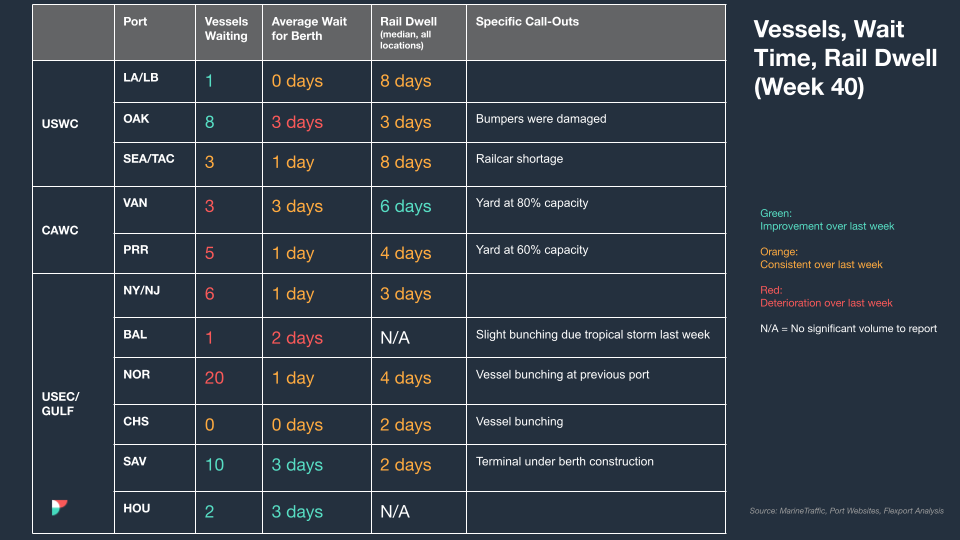Trends To Watch
- [Ocean – Europe] The European Commission (EC) has decided not to extend the Consortia Block Exemption Regulation (CBER) when it expires on April 25, 2024. In place since 2009, the CBER was designed to encourage competition in the shipping industry. What impact this will have on shipping to and from Europe remains unclear. (source: JOC)
- [Ocean – Canada] Talks continue between representatives of the Port of Montreal Longshoremen’s Union and the Maritime Employers Association (MEA) as their current collective agreement expires on December 31, 2023. Longshoremen at the Port of Montreal are looking for wage increases of at least 20% over the next four years and full job security in three years, while the port operator is looking to limit how many workers get that level of security and a contract that guarantees union peace through the end of the decade.
- [Ocean – TPEB] October capacity is down as expected with Golden Week, however it’s less of a drop than we saw during Lunar New Year (LNY). November’s outlook is good, but subject to change. Demand ex-China is just starting to come online this week, bookings over the next 1-2 weeks will determine capacity for November. Q4 outlook: Expect to see a good number of blank sailings, but with overall capacity comparable to Q2/Q3 numbers. The pre-LNY push will likely start in December. More new builds will continue coming online, carriers will most likely offset with more blanks and by moving smaller vessels to other markets.
- [Air Freight – Global] In September, global air cargo tonnages increased by nearly 3% and rates rose by 5% compared to August, according to WorldACD Market Data. Despite this boost, September tonnages were still down 2% year on year, marking the smallest monthly YoY decrease in 2023.
- [Ocean – FEWB] The market on the EUR trade remains flat. As expected, carriers are planning another round of GRI from Nov. 1, aiming to push up the market again to cover operation costs. Ocean Alliance announced 5 more void plans for November, in order to support the potential GRI carriers may plan more voids if cargo recovery is still not ideal from Mid-Oct. MED trade: Following NEUR, there’s also a GRI for WMED, but so far oversupply remains the case. Expect the market to drop further if the current round of voided sailings doesn’t lead to general strengthening.
- [U.S. Exports] TAEB and TPWB are both seeing blank sailings impacting equipment levels at inland IPI locations. Please book 2+ weeks prior to CRD to ensure an optimal booking.
N. America Vessel Dwell Times

The Week In News
ILWU Dockworkers Union’s Sway at West Coast Ports Is Tested in Bankruptcy
In advance of a judgment against it for what a federal jury found to be illegal work stoppages at the Port of Portland in 2019, the International Longshore and Warehouse Union (ILWU) has declared bankruptcy. The ILWU represents more than 22,000 workers at 29 ports along the U.S. West Coast, and as such wields a significant amount of leverage when it comes to port operations and controlling the flow of goods entering and leaving the U.S.
IATA: First Air Cargo Demand Growth in 19 Months
As part of its August air freight analysis, the International Air Transport Association (IATA) released numbers showing that global cargo tonne-kilometers (CTKs) were up 1.5% year-on-year. At the same time, they showed CTKs being 1.3% below their pre-pandemic level in 2019. According to an IATA representative, “Air cargo demand grew by 1.5% over the previous August. This is the first year-on-year growth in 19 months, so it is certainly welcome news. But it is off a low 2022 base and market signals are mixed.”
Source from Flexport.com
